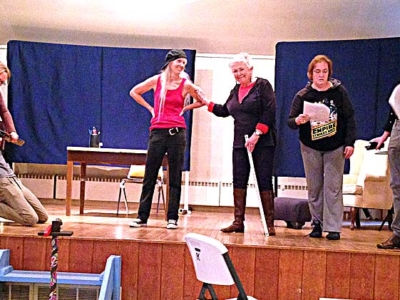Sheriff’s inquiry faults officer
- Published: March 27, 2014
Seven months after the shooting standoff in Yellow Springs that ended with the death of Paul E. Schenck, the Montgomery County Sheriff’s department released the findings of an investigation of the two Greene County officers who fired weapons during the event. The findings, dated Feb. 18, were released to the public last week, immediately following the dismissal of Major Eric Spicer of the Greene County Sheriff’s Office, one of the officers who fired a weapon during the shooting on the night of July 30 and early morning of July 31.
Greene County Sheriff Gene Fischer declined to say last week whether Spicer’s dismissal was related to his conduct during or after the incident. But Montgomery County investigators found that Spicer violated five of the 13 allegations of improper conduct leveled against him by his department. He had been placed on paid leave since the shooting incident, per routine policy. Spicer had 24 years of law enforcement experience and had worked for the Greene County Sheriff for nine years.
The other officer implicated in the investigation, Deputy James Hughes, a sharp shooter with the Greene County Regional SWAT team, was found to have engaged in proper conduct by Montgomery County. He was also cleared of any criminal wrongdoing by the Bureau of Criminal Investigation, whose director Ohio Attorney General Mike DeWine presented that agency’s findings in November.
While the Montgomery County investigation answered some questions about why responding officers were led to the wrong house during the standoff, a fact that was included in the BCI’s report, it did not comment on the overall tactics of the emergency response. The investigation did not address why, for instance, 71 officers from 17 law enforcement agencies were brought to the scene of the standoff at Schenck’s home at 280 North High Street, where between 10:45 p.m. July 30 and 2:30 a.m. July 31 Schenck shot over 190 rounds from four sides of his house using a multitude of semi-automatic weapons.
Sheriff Fischer declined to comment directly about the tactics employed during the incident, saying only that agencies gauge their response on the nature of the disturbance. And to their knowledge at the time, all the agencies thought they might be dealing with a mobile suspect — an erroneous perception that according to the investigation was reinforced repeatedly throughout the night by Major Spicer.
“You only need enough people to take care of what you’re dealing with — and we had what we thought would have been a mobile person that night,” Fischer said.
Montgomery County Sheriff Phil Plummer initiated the investigation at Fischer’s request directly following the July 30–31 shooting. From August through November, investigators interviewed 33 officers from over a dozen agencies and reviewed reports from the BCI, dispatch records, the coroner’s report, and agency policies. Based on the information compiled, investigators sustained five allegations that Spicer had 1) failed to follow orders to set up a command post when he arrived on the scene, 2) failed to notify other officers or command that he had fired his weapon, 3) broken lights at a residence without notifying dispatch or command, 4) led officers to the wrong house, and 5) deleted the incident report he filed with his department on Aug. 7. Other related allegations against Spicer were dismissed due to lack of evidence.
Regarding the first charge, Spicer was the highest ranking officer when he arrived to the scene, and as such, was supposed to gather intelligence from existing officers and coordinate the command post for reinforcements until a higher ranking officer or SWAT commander arrived, according to testimony taken from Montgomery County’s officer interviews. Instead, again according to testimonies, Spicer failed to take command and “inserted himself into the inner perimeter” where police were receiving direct fire.
On the second charge, when Spicer arrived, he took up a rifle and returned suppression fire in the general direction where he thought the suspect was located. Though other officers were stationed near him, no one else fired, and no one else saw a target. Spicer then failed to tell anyone near him or radio to command that he had fired his weapon and identify his target.
On the third charge, Spicer broke porch lights at 234 North High Street to protect the cover of officers in the field, but the action caused the homeowner to believe someone was trying to break into that house. The resident called 911, which, because Spicer failed to notify command of his actions, created the impression that the suspect might be mobile. That misinformation influenced law enforcement’s decisions for the rest of the night.
On the fourth charge, Spicer indicated during his interview, corroborated by many others, that he had not gathered sufficient intelligence when he first arrived to learn which residence was Schenck’s home. And as he was a ranking officer in a forward position, he ended up directing over half a dozen other officers to the wrong house as well. Some of those officers did not learn of the correct address until the incident was over, and Schenck’s body was found in his home around 4:30 a.m.
According to testimony, a family with a young child was in the misidentified home, 250 North High Street (one house south of Schenck’s home), throughout the entire event. Several officers testified that they were targeting 250 all night and that had a resident emerged from that address and not immediately followed orders, “bad things would have happened,” one officer said.
“We may have shot someone that we shouldn’t have,” the officer said in the report.
In addition, according to several testimonies, because Spicer thought the suspect was mobile, he told several officers he wanted a vantage point from inside a nearby residence. Again without notifying command, he and the other officers attempted to gain entry into 246 North High, whose owners also called 911 to complain of a possible break-in. That event caused further chaos and confusion for some of the officers, the report indicates.
On the fifth charge, based on testimony from several record keepers and administrators, investigators found that Spicer did delete the report of the July 30–31 event, which he was asked to submit in August. Spicer denied the charges in his testimony.
In his defense, during the testimony he gave in November, Spicer said that his understanding was that in an active shooter situation he was to go directly into the scene, “engage the shooter” and “contain…hopefully capture or take this guy out” in order to protect the community and other officers. His perception that Schenck was mobile was caused by the number and sound of different weapons firing and ricocheting around the homes, cars and trees in the area, which several officers agreed sounded like the suspect or suspects were outside and moving around. Spicer also said during his testimony that he “would not change a thing he did that night.”
The allegations against Spicer that were dropped include that Spicer fired at a house without target acquisition; that he had not received the most recent weapons certification and was unqualified to fire a weapon; that he shot at the wrong house; that he argued with commanders about the suspect’s location; that he disobeyed direct orders; that he entered the crime scene and potentially contaminated it; that he took the copy of his report from the county records department.
The full report from Montgomery County will be posted at ysnews.com on Thursday.
The Yellow Springs News encourages respectful discussion of this article.
You must login to post a comment.
Don't have a login? Register for a free YSNews.com account.

Parkinsons.jpg)













No comments yet for this article.